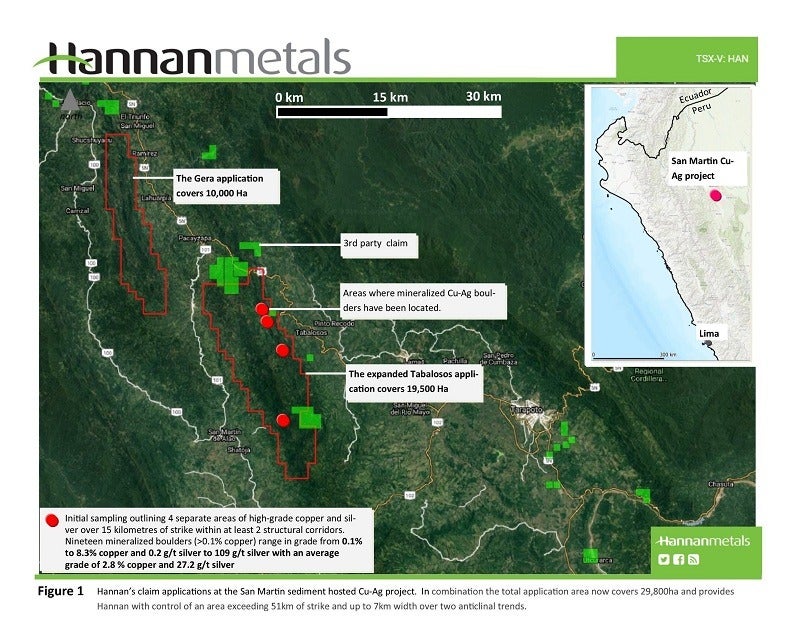
A district-scale exploration target is now secured with applications covering more than 50 kilometres strike of the prospective host horizon.
Highlights:
- Hannan has doubled the area of its mineral claim applications at the San Martin sediment-hosted copper-silver project;
- Permit applications now cover 29,800ha and provide Hannan with control of an area exceeding 51km of strike and up to 7km width over two anticlinal trends;
- Hannan’s experience in the interpretation of seismic data for mineral exploration has provided a unique target development opportunity;
- Field work on new areas set to start in mid-March 2019;
Michael Hudson, Chairman and CEO states, “San Martin is a high-grade copper and silver discovery in north-central Peru where Hannan has secured over 50 kilometres of prospective mineralized horizon. Hannan’s first mover position has allowed claiming of a district-scale target, strengthened by the advantage of basin scale seismic data in a new sediment-hosted copper terrane with a geological record similar to basins that host giant sediment-hosted copper deposits.”
Hannan has doubled its mineral claim application area at the San Martin sediment-hosted copper-silver project in north-central Peru. Claim applications at Tabalosos have been increased to 19,500ha, and a new application (“Gera”) selected, which covers 10,000ha. Gera is located immediately NW of Tabalosos along an anticline that exposes the prospective Saraquillo Formation for an addition al 25km of strike . The total application area now covers 29,800ha and provides Hannan with control of an area exceeding 51km of strike and up to 7km width over two anticlinal trends. Field teams will be mobilized to the expanded Tabalosos application and the new Gera application in mid-March 2019.
The San Martin project lies in the Sub-Andean zone of Andean Cordillera. Since the 1970’s the area has principally been explored for petroleum, delivering large seismic datasets similar to those being used by Hannan for targeting of zinc in Ireland. Seismically-defined basin structures and stratigraphy are now being interpreted in the context of sediment-hosted copper mineralization.
The Sub-Andean zone is underlain by a series of retro-arc foreland basins that were inverted during the Mid-Eocene and the Miocene. The inversion exposed a rift sequence initiated in the late Permian, composed of red beds and thick basin-wide evaporites. These rocks are contemporary to the Pucara and Mitu Groups in western Peru. The geological history shows a strong similarity to sedimentary basins which host giant sediment hosted copper deposits with respect to the stratigraphy, basin architecture, presence of thick evaporites and long periods of quiescence.
Copper and silver mineralization is hosted by the 150 Ma Saraquillo Formation, which was deposited in an intra-continental basin during the Jurassic-Early Cretaceous period. The Saraquillo Formation is 1.2-1.8 kilometres thick and extends for over 1000 kilometres of strike. The Saraquillo Formation is spatially associated with salt domes which supports the seismic observations of widespread evaporitic strata, with several small artisanal salt and copper mines present in the area. The Cordillera Ayu Mayo is comprised of two parallel anticlines striking north-northeast and flanked by east and west dipping thrusts. Dips vary from 0 to 35 degrees and steepen immediately adjacent to thrust faults.
Copper mineralization discovered to date is associated with the contact of fine-grained reduced carbonaceous sandstones with highly oxidized red beds of the Saraquillo Formation. Chalcocite is the dominant copper sulphide and it is always found together with carbonaceous material. Chalcocite occurs as fine disseminations, fracture filling and centimetre-sized massive aggregates. Secondary copper minerals are common on exposed surfaces. Albitization and silicification is associated with the mineralization, where the former dominates in more strongly mineralized samples.
Initial sampling recently announced by Hannan outlined four areas of high-grade copper and silver over 15 kilometres of strike within at least two structural corridors within the Tabalosos claim application area. Nineteen grab samples from mineralized float in river beds (>0.1% copper) ranged in grade from 0.1% to 8.3% copper and 0.2 g/t silver to 109 g/t silver with an average grade of 2.8% copper and 27.2 g/t silver.
Management of Hannan have had significant prior experience in Peru, which is the world’s second largest copper producer, with steady growth predicted over the coming years. The country’s copper output is forecast to increase from 2.5 million tonnes (“Mt”) in 2018 to 3.8Mt by 2027, averaging 4.7% annual growth. Sediment-hosted deposits are the world’s second most important source of copper accounting for approximately 20% of world production.
Source: Company Press Release






